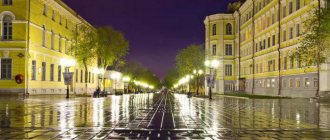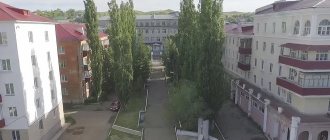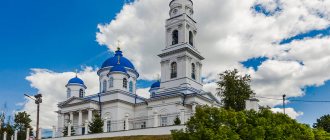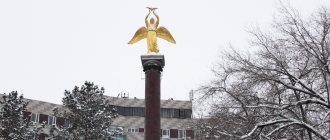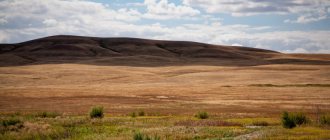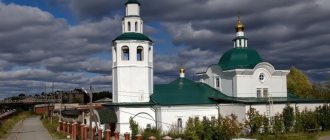In the south of the Urals, 1441 kilometers from Moscow on the Ural River lies a city that ranks 28th in terms of population among Russian settlements - the city of Orenburg . The Orenburg region neighbors Kazakhstan, Tatarstan, Saratov and Samara regions. The length of the region is truly amazing; from west to east it is 755 km, and from north to south 425 km.
Orenburg boasts an unusual history of its founding. The city was founded three times: the first time at the confluence of the Ori River with the Yaik River, the second time the fortress was founded on Red Mountain, and the third time at the site of its modern location on the banks of the Urals. The founder of the city was the scientist, geographer and politician I.K.
Kirilov, who founded the fortress at the behest of Anna Ionovna with the aim of further development of the lands of Siberia. Why did Kirilov call the city Orenburg? The name was chosen because Orenburg was planned as a fortified city on the banks of the Ori.
In 1938, Orenburg was renamed Chkalov in honor of a Soviet pilot who had nothing to do with the city. In 1957, Orenburg was returned to its original name
The impetus for the rapid development of the city was the discovery of a gas field in the 70s of the last century. Orenburg today is a modern, well-maintained city with developed infrastructure and industry.
Climatic conditions of Orenburg
Orenburg belongs to a zone of moderate continental type of climate, which turns into sharply continental. This fact has a direct impact on the sharp fluctuations in the average annual temperature in the region. So in summer the air can warm up to 40 or even 43 degrees, and in winter the temperature can drop to -45 degrees; the temperature minimum was recorded in 1942 and was -49 degrees. The average annual temperature is 5.3 degrees.
Autumn in Orenburg is short, it begins in September, and in November winter comes into its own. The weather in winter is unstable: severe frosts are replaced by a slight minus. At the end of March, spring begins in the city, but even at the end of May, cold weather can unexpectedly return to the region. Summer is short but quite hot, starting in June and ending at the end of August. There is little precipitation, which often leads to droughts.
Moreover, in the west and north of the Orenburg region there is slightly more precipitation than in the east and south. There is a trend: the further east and south, the drier.
Snow in Orenburg falls already by the beginning of November and remains until April. Moreover, the snow cover reaches its maximum height in March. The region is characterized by severe snowstorms with gusty winds, wet sticky snow or even rain. Blizzards appear due to the influence of southern and western cyclones that pass through the region. On average, there are about 50 days with blizzards per year.
It is not surprising that there are a lot of thunderstorms in Orenburg - there are about 20-30 thunderstorm days every year, most of them in July.
Planetarium
The Orenburg Planetarium is 65 years old. It was the eighth planetarium in the country. Initially, during Soviet times, it was located in the building of the Caravanserai , and in the 1980s it was allocated another building.
From the very first minutes, visitors are immersed in the cosmic world. The hall where events take place is brightly decorated. Planets and various spacecraft are located under the ceiling. The windows also display children's works on space themes. The planetarium offers programs for both children and adults. Most of them take place in the form of lectures and films. Equipment with a rotating dome immerses the viewer in outer space. But if you want to watch a real solar eclipse, you will be asked to go to another room where a powerful telescope is installed. It can easily “deliver” you to the rings of Saturn or to the Milky Way .
Ecology of Orenburg
The environmental situation in Orenburg cannot be called favorable, since there are many industrial enterprises operating in the city that have a direct impact on the cleanliness of the air. The region occupies a leading position in the ranking of cities with the highest emissions of harmful substances into the atmosphere, hydrosphere and soil. Thus, about 900 thousand tons of pollutants are released into the air every year. Among the cities of the Urals, Orenburg is second only to the Chelyabinsk and Sverdlovsk regions in this indicator.
In general, the region is home to more than 14 thousand enterprises and mineral deposits that have a direct impact on the environment, including 74 chemical plants and 130 oil and gas fields. Metallurgical and fuel and energy enterprises account for about 47% of all emissions.
A large number of vehicles, including private ones, have a significant impact on air cleanliness. It accounts for an average of 63% of total emissions into the atmosphere. Moreover, from year to year this figure is becoming higher and higher.
The situation in the region with clean drinking water is also difficult. Not all the water that comes through the pipeline to the homes of city residents meets all the standards and indicators of good drinking water. Urban landfills contribute to the pollution of underground sources, because the movement of water occurs in the direction from the landfills.
Cable car
In 2006, a cable car was opened Orenburg , which makes it possible to travel from Europe to Asia . Its length is 233 meters. Passengers travel in cozy translucent cabins. This project even took the status of “The most comfortable cable car in Russia” . The speed of your movement through the air will be 3 m/s, so during the flight passengers have time to take pictures of the river, bridge and embankment from a height of 70 meters.
Population of Orenburg
According to the latest data, 565,341 people live in Orenburg. It cannot be said that the city’s population is constant, far from it. In the period from 1863 to 1995 it constantly increased, but from 1996 to 2001 and from 2004 to 2009 it steadily decreased. Since 2012, the population has been growing, which can be explained by both rising birth rates and migration from neighboring regions. What attracts migrants to Orenburg? Of course, work. Here they work in agricultural and industrial enterprises, on numerous construction sites and in mining operations.
Orenburg is a multinational city. Representatives of more than 100 nationalities live here. Russians account for about 83.5% of the total population, in second place are Tatars, they number 7.8%, Kazakhs 2.0%, slightly less Ukrainians, there are 1.97%, 1.1% Bashkirs, 0.63 % Armenians and 0.52% Mordovians.
Despite such a multinational composition, interethnic conflicts almost never happen in the city; Orenburg is a friendly city. The proximity of different peoples has led to the fact that the culture and life of the local population consists of an interweaving of traditions and represents a close interaction of ethnic cultures.
Orenburg residents, as a rule, speak two languages. Absolutely everyone knows Russian as a state language. The second language is the national language, the one spoken in the family or among representatives of the same nationality.
Among the age groups in Orenburg, the working age population predominates, accounting for about 67%, while pensioners account for only 17%. As for the working population, Russians, as a rule, work in industrial enterprises, while Kazakhs and Mordovians work primarily in agricultural enterprises in the region.
Victory Park
In summer in Orenburg it is pleasant to walk around the city. It pleases with greenery and fountains. It can even be a pity to waste time on museums. In this case, I recommend visiting an open-air exhibition of military equipment. It is located in Victory Park . Here you can see tanks, planes, self-propelled guns and even trains. The exposition plays out in a very interesting way. You can climb in the trenches, climb onto a train or sit on a cart. Everywhere there are information signs telling about the exhibit.
Famous people of Orenburg
The history of Orenburg is inseparable from the life and work of its inhabitants. The Orenburg land was glorified by many famous people of our country. A. S. Pushkin came here in 1833, the poet collected information in the city about the Pugachev uprising, which, as we know, swept the Orenburg land. Later, based on the materials received, Pushkin wrote his “Captain's Daughter”.
The Orenburg land is connected with the life and work of I. A. Krylov, G. R. Derzhavin, N. M. Karamzina, A.N. Pleshcheeva. N. I. Yeltsin, L. A. Guzeeva were born here, the famous conductor M. L. Rostropovich spent his childhood here, P. A. Strepetova M. M. Tarkhanov performed on the stage of the local drama theater, actor L. S. lived in the city. Bronevoy and actress A. Ya. Sadovskaya, poet T. G. Shevchenko served.
The title of Honorary Citizen of the city was awarded to 41 people, including cosmonaut Yu. A. Gagarin, conductor M. L. Rostropovich, politician, minister S. Yu. Witte.
ORENBURG
Orenburg. View of the city. Information Work Department of the Orenburg City Administration
ORENBURG, city in Russia, adm. center of the Orenburg region Us. 556.1 thousand people (2013; within the city district - 571.8 thousand people). Located in South Cis-Urals, on the river. Ural (the banks are connected by a pedestrian bridge with symbolic signs of the border between Europe - on the right bank and Asia - on the left, 1980s, and a cable car, 2006), near the confluence of the river. Sakmara. Junction of railways and roads. Intl. airport.
In May 1734 beginning. The Orenburg expedition, I.K. Kirilov, compiled the “Privilege for the City of Orenburg” [approved by Senate decree dated July 7 (18), 1734], which granted special rights and benefits to the future city, which was planned to be built on the borders with the Kazakhs. lands. O. was considered as a kind of “window to Asia” (by analogy with St. Petersburg - “window to Europe”), a stronghold to the southeast. borders of the country. Initially the city was called. O. (now the city of Orsk) was founded by Kirilov on August 15 (26), 1735 at the confluence of the river. Or in the river Yaik (now Ural), in 1736 on the site of the present. O. Kirilov founded the Berd fortress (on the right bank of the Yaik river). In 1738 beginning. To the Orenburg Commission, V.N. Tatishchev moved the first O. due to the difficulty of communication approximately 192 km downstream of the river. Yaik, in the Krasnaya Gora tract (in 1742–1837 Krasnogorsk fortress, then the village of Krasnogorskaya, now the village of Krasnogor). I. I. Neplyuev, who replaced Tatishchev, in 1742 again moved the lake another approximately 75 km downstream of the river. Yaik, in place of the Berd fortress. Construction of the new lake began on April 19 (30), 1743. engineer general G. von Shtokman (Berdsk fortress was moved 6 km north, to the bank of the Sakmara River, now within O.). Center of the Orenburg province (1744–1781/82; 1797–1802; 1865–1920; 1921–28). Since 1748 military. and adm. center of the Orenburg Cossack army. To develop trade with Wed. Asia on the left bank of the river. Yaik, about 3 km from O., the Exchange Yard was built in 1749–54 (in the form of a stone fortress; operated until 1914). During the Pugachev uprising of 1773–75, E. I. Pugachev’s headquarters for some time was the Berd Fortress. O. was besieged by the rebels (October 1773 - March/April 1774), but was not taken thanks to the skillful actions of the Orenburg governor, Lieutenant General I. A. Reinsdorp. Regional and district city of the Ufa governorate (1781/82–1796), only a district city of the Orenburg province. (1802–65). The residence of the Orenburg military was located in O. governors (1796–1851), Orenburg and Samara governors general (1851–64), Orenburg governor general (1865–81). From the end 18th century O. is a political place. exile, members of the Greek served here. secret society "Filiki Eteria" (1821–24), participants in Polish secret societies (including J. Witkiewicz, E. Zheligovsky, T. Zan, V. Migursky, Z. Sierakowski, etc.), the Polish uprising 1830–31, Polish uprising of 1863–64, Petrashevites (in 1852–58, 1859 A. N. Pleshcheev served in exile and served in O.), populists, social democratic leaders. movements. G.S. Karelin and A.A. Alyabyev also served exile in O. From 1799 to 1859, the Orenburg Border Commission operated in O., in charge of the affairs and administration of the Kazakhs of the Junior Zhuz (the so-called Trans-Ural Kyrgyz steppe of the Orenburg department, in 1859 it was transformed into the Orenburg Kyrgyz region). In 1859–68, the regional administration of the Region of the Orenburg Kirghiz was located in O., in 1868–1920 - the regional administration, command administration. troops and military residence. Governor of the Turgai region. In 1862 O. lost the status of a fortress (back in 1860 the ramparts in the city were razed and the ditch was filled in). Center of the educational district (1874–1907).
In the 2nd half. 19 – beginning 20th centuries the industry began to develop, the largest enterprise - Ch. railway workshops (1905). In 1877, railway traffic was opened. line Samara - Orenburg, in 1905 - Orenburg - Kubek, in December. 1914/Jan. 1915 – Orenburg – Kuvandyk. During World War I, refugees from the West were settled in O. regions of the country, hospitals operated.
In O. 20–27.7 (2–9.8).1917 the 1st All-Bashkir kurultai (congress) was held, at which the creation of autonomy was supported and the Bashkir Shuro (council) was formed, 12/8–20/1917(12/21/1917–1/2/1918 ) - 3rd All-Bashkir Constituent Kurultai, it approved the creation of bashkir. autonomy and its government was formed. 21–26.7 (3–8.8). 1917 in O. the 1st All-Kyrgyz (All-Kazakh) Congress was held, at which the Alash party took shape, in December. 1917 – 2nd All-Kyrgyz (All-Kazakh) Congress, where the Kyrgyz (Kazakh) autonomy “Alash-Orda” was proclaimed.
With the beginning of the Civil war 1917–22 O. in November. 1917 – Jan. 1918 was under the control of the forces of A.I. Dutov. On January 18 (31), 1918, the city was occupied by Bolshevik detachments. On July 3, 1918, under the conditions of the Czechoslovak Corps, the 1918 uprising was taken under control by participants in the anti-Bolshevik Cossack uprising, and soon Dutov’s troops re-entered the city. On January 22, 1919, it was again occupied by Bolshevik detachments. On Sept. 1919 Dutov's Orenburg army attempted to occupy O., but was defeated by units of the Red Army. Center of the Orenburg-Turgai province (1920–21). The capital of the Kyrgyz (from 1925 – Cossack) ASSR as part of the RSFSR (1920–25). District (since 1928) and district (1928–30) center of the Middle Volga region. (1928–29) and the Middle Volga region (1929–34). Since 1934, the center of the Orenburg (in 1938–57 – Chkalov) region. In 1938–57 it was called Chkalov. In 1939, the Orenburg Down Shawls Factory was founded in the city (initially as an artel). In Vel. Otech. war in O. from the west. areas of the country evacuated St. 40 large enterprises (including the Moscow plant "Frezer" and others). In 1980, railway traffic was opened. line Orenburg - Muraptalovo.
Gostiny Dvor. 1750–54. Architect I.V. Muller. Photo by P. S. Pavlinov
From the Orenburg fortress, the remains of the Nikolsky Bastion, the Water Gate, and the construction of the Cannon Yard have been preserved. On the territory of the former The fortress with a preserved rectangular layout contains buildings from the 18th–19th centuries: the ensemble of the Gostiny Dvor with a gate tower and corner bastions (1750–54, architect I.V. Muller; rebuilt in 1877–98), the house of P.I. Rychkov (1753 ), in the style of classicism - the buildings of the Ordinance House (commandant's office; early 19th century, built on at the end of the 19th century), the Officers' Assembly (early 19th century, architect M. P. Malakhov; now a children's music hall. school), 1st Neplyuevsky Cadet Corps (1824–25; rebuilt in the 2nd half of the 19th – early 20th centuries for a women’s gymnasium), Assembly of the Nobility (1836–41, architect A.P. Bryullov); rotundal gazebo (1837, moved from the Trans-Ural Grove in the late 19th century), Catholic. Church of Our Lady of Loreto (1844–47); in the spirit of eclecticism - the house in which A. I. Berg was born, the men's gymnasium (1868–69), theological school (1884, architect F. D. Markelov), the estate of V. V. Chistozvonov (end 19 - early 20th centuries) and E. M. Gorodissky (1906).
Guardhouse building. 1854–56. Architect I. P. Skalochkin. Now the Museum of the History of Orenburg. Photo by P. S. Pavlinov
Specificity of architecture O.'s appearance is a combination of European. and east styles - can be traced in the buildings of the representative office of the Bukhara emir (19th century), the Border Commission (late 18th - early 19th centuries, built on in the mid-19th century, in the Moorish style), the office of the Orenburg engineer. distance (1879–82, in the neo-Gothic style; restored in 1976), in the Khusainiya ensemble (mosque with minaret, 1892–94; madrasah, completed in 1905–06; teachers’ houses). On Embankment st. located: military house. governor with 2 wings (1836–41, architect G. Gopius; now one of the buildings of the Pedagogical University), a guardhouse in the neo-Gothic style (1854–56, architect I. P. Skalochkin; now the Museum of the History of O.; clock -chimes were restored in 1978–86), a 5-story building of the 2nd Cadet Corps (1871–74; from 1927 a military pilot school, in 1938–93 a Military Aviation School for pilots, in 1955–57 Yu studied here. A. Gagarin), Moshkov houses (1877 and 1905–1906) with a brewery (1886). On the street Kobozev – estates of A.G. Filippov, M.V. Savelyev and others (all 19th century), ch. building and store of the trading house of A. I. Zaryvnov (19th century), buildings of branches of the Volga-Kama (1880s) and Azov-Don (1909–10) banks, the Bristol Hotel (1907).
Complex of a caravanserai with a mosque. 1837–46. Architect A.P. Bryullov.
In 1837, construction began on Novaya Slobodka (north of the fortress); its fan-shaped layout has now been reorganized into a radial-ring layout. North and northwest of the former. the fortresses have been preserved: the bashk complex. caravanserai with an octagonal mosque, a minaret and the command building of the Bashkir-Meshcheryak army (1837–46, architect A.P. Bryullov), the ensemble of the Nikolaev Women's Institute (1830–40s, rebuilt in late 19th century), Pokrovskaya c. (1853, the chapters and bell tower were demolished in 1930, restored in the 1990s), the bishop's house (1865–68), buildings of the Assumption Monastery. [1874, closed in 1923, restored since 2010; water-blessed chapel (since 2004 in honor of the icon of the Mother of God “Life-Giving Spring”), etc.], c. St. Demetrius of Thessalonica in the Russian style (1890, the domes and bell tower were restored in the 1990s), c. St. John the Evangelist (1901–02), 6 mosques ser. 19 – beginning 20th centuries, residential buildings in brick style. Among other surviving buildings: railway. station (1876, reconstructed in 1936 and 2004–05), fire station with tower (1876), water towers in the locomotive depot (1870s) and on the avenue. Pobeda (1927–28, architects I.V. Ryangin, S.S. Puntikov), steam mill by V.Kh. Yurov (1901–03). East of former fortress at 19 - beginning. 20th centuries the Cossack Forstadt area was built up (St. Nicholas Cathedral, 1883–1886, new dome – 1988–90, bell tower – 1994). On the left bank of the river. Ural - the foundation of the wall of the Menovoy Dvor, the Transural Grove cultural and recreation park (310 hectares), the Ural rest house.
Apartment building in Art Nouveau style (1910), etc. Chime Tower (1993–97). Photo by P. S. Pavlinov
In the beginning. 20th century Art Nouveau style was actively developing in O.: the Grieves and Co. trading house (1905–06), the building of the Mutual Credit Society (1908, now a branch of Sberbank), a post office, numerous. merchant mansions [including the houses of S. G. Frolov (1912), V. Troshin (1913)]. Among the buildings in the neoclassical style are the apartment building of P. F. Pankratov (1914), the house of the Moscow agency. fire insurance company (1914–16, architect I.F. Kuretsky; now the mayor’s office). In the 1930s all in. In parts of O., new residential areas were built: Novostroika, Rent, Syreika. In 1936–40, the House of Soviets was erected on the site of the Kazan Cathedral (architect I. I. Vinogradov). Since 1945 in the style of owls. neoclassical built: Dramatic. Theater named after M. Gorky (1947–49, architects I. S. Avvakumov, A. N. Postnikov; reconstruction - 2006), staircase descending to the river. Ural (1955, architect P. T. Perminov), ensemble of the Regional Exhibition of People's Achievements. farms with a concert hall (1956, now the Philharmonic). In the 1970s–80s. (according to the general plan of 1969) residential areas were built: Yuzhny, Mayak, Khlebny Gorodok, Severny, Vostochny, etc., houses of culture “Russia”, “Druzhba” (now “Gazovik”; 1983), the “Fakel” hotel; in the 1990–2000s - so-called Tower with chimes (1993–97, architect A. S. Ivanov), c. St. MC. Tatiana at Orenburg University (2000), c. St. Sergius of Radonezh in the Rostoshi district (2005–06), a cathedral in honor of the Kazan Icon of the Mother of God with elements of neo-Byzantine style in the Stepnaya district (2005–11), Vvedensky Cathedral (2007–2011; reconstruction of the temple 1755–58, destroyed in 1931), wood. Church in honor of the Tabyn Icon of the Mother of God (2003). To the east in the outskirts in 2005–09, the cultural complex “National. village" with 10 different. farmsteads. In 2008, a new general plan of the city was adopted; Gostiny Dvor and the Center are being reconstructed. market (architect A.I. Agafonov).
Monuments: V. I. Lenin (1925, sculptor V. V. Kozlov, architect I. V. Ryangin; 1963, sculptor V. B. Pinchuk), heroes of Civil. war (1931, sculptors M. F. Herzog and E. N. Krestyanson), V. P. Chkalov (1953, sculptor I. A. Mendelevich, architect A. S. Andreev), Yu. A. Gagarin (1986, sculptors Yu. L. Chernov, Yu. V. Aleksandrov), A. S. Pushkin and V. I. Dal (1998, sculptor N. G. Petina), Governor General V. A. Perovsky (from the Perovsky family; 2005, sculptor Petina), Orenburg Cossacks (2007, sculptor V. Nikolaev, architect N.A. Chudin-Alexandrin), P.I. Rychkov (2012, sculptors A.E. Vargot, M.S. Vedernikov); memorial “To those who fell for the Soviet Motherland” (1973, architect A. A. Andreev, sculptors Aleksandrov, Chernov), a memorial with the Eternal Flame to the Orenburg residents who fell during the Great Ages. Otech. war (1985, architect A.I. Agafonov, sculptor N.A. Ishmukhametov).
Among scientific institutions - regional branches: RANS, Ros. eco-friendly Academy, Academy of Electrical Engineering. Sciences, Int. Academy of Sciences of Ecology, Human Safety and Nature; All-Russian Research Institute of Beef Cattle Breeding of the Russian Academy of Agricultural Sciences, Scientific Research Institute of the village. House of Russian Academy of Agricultural Sciences, Scientific. Center of the Ural Branch of the Russian Academy of Sciences (it includes the Institute of Cellular and Intracellular Symbiosis, the Institute of Steppe, the Department of Geoecology, the Department of Biotechnical Systems, the Orenburg Branch of the Institute of Economics of the Ural Branch of the Russian Academy of Sciences), N.-and. Center for the History of the Peoples of the South. Ural, Research Institute of History of the South. The Urals and the Cossacks of Russia. State universities: Pedagogical. University (1915, current status since 1996), Agrarian University (1930, current status and name since 1995), Med. Academy (1944, current status since 1994), University (founded in 1955 as an evening department of the Kuibyshev Industrial Institute named after V.V. Kuibyshev, name and status changed, since 1996 current status), Institute Arts (since 1997 named after L. and M. Rostropovich), Institute of Management (1999); branches: Moscow universities - Academy of Labor and Social Relations, Ross. People's Academy farms and government services under the President of the Russian Federation, Ros. state trade and economic University, Ros. state University of Oil and Gas named after. I. M. Gubkin, Volga State. University of Telecommunications and Informatics (Samara). There are also a Theological Seminary (1883, revived in 2009), and a number of non-states. universities, including the Institute of Economics and Culture, Institute of National. safety and innovation technologies. 4 regional libraries, including Universal Scientific. fuck them. N.K. Krupskaya (1889), Center. mountains fuck them. N. A. Nekrasov (1928, unites 26 branch libraries) and others. Museums: governor’s local history museum (founded in 1830; now in the house of merchant A. I. Yenikutsev, 1836–38), regional museum. arts (1960; in the building of the City Duma, 1814, architect M. P. Malakhov, expanded in 1875), history of O. (1983), memorial museum-guardhouse of T. G. Shevchenko (1989), memorial museum-apartments of Yuri and Valentina Gagarin (2001), the Rostropovich family (2001), the Museum of Military Glory and the Afghan War (2001), “House of Memory” (2003), the memorial complex-museum “Salute, Victory!” (2005), history of the Orenburg Cossacks (2007), Gallery “Orenburg Down Shawl” (2012), etc.
Dramatic Theater named after M. Gorky (1869), Regional Puppet Theater (1935), Regional Music Theater. comedy (in O. since 1936), Tatar drama. Theater named after M. Faizi (1990), Municipal Puppet Theater “Pierrot” (1991). Orenburg Russian folk choir. Regional Philharmonic (1943), consisting of: Chamber Orchestra (1990), chamber ensemble of ancient and modern. music "Divertiment" (1994), etc. Municipal groups: Orenburg Chamber Choir (1993), brass band "Orenburg" (1997), Ensemble Russian. song and dance “Russian Expanse” (founded in 1990 at the Palace of Culture “Russia” as an amateur, since 1996 professional). They are held at different intervals: International. theater festival "Gostiny Dvor" (since 1994), Int. festival of puppet theaters “Orenburg Watermelon” (since 2001). Children's room village named after P. A. Kobozev (1953, one of the longest in Russia: length approx. 5.6 km).
Popular sports include football, volleyball, bandy, and table tennis. The greatest success was achieved by the Gazprom Fakel table tennis club, which won the Russian Championship (2009), the Russian Cup (2006) and the European Cup (2010), held in Orenburg.
The base of the mountains. economics – production and processing of oil and natural gas, electric power, mechanical engineering, light and food industries. The Orenburg field is being developed. Processing of hydrocarbon raw materials is carried out at the largest Orenburg gas chemical plant in Russia. complex (structural division of the company Gazprom Dobycha Orenburg; it includes gas processing, helium plants and other enterprises): installed capacity St. 37 billion m3 of gas per year; loading your own raw materials St. 50%, raw materials from Kazakh are also processed. Karachaganak deposits, etc. Main. complex products - dry and liquefied gas, stable condensate with oil, a wide fraction of light hydrocarbons, ethane (approx. 80% of Russian production, 2011), sulfur (approx. 20%), liquid oxygen and nitrogen; The entire volume of growth is also produced here. helium and odorant.
Leading mechanical engineering manufacturers. products - factories: drilling equipment (drilling tools and pipes for geological exploration, oil and gas production), locomotive repair (branch of the Zheldorremmash company; overhaul of mainline and shunting diesel locomotives, spare parts for rolling stock and overhead contact network), "Orenburg Radiator" "(as part of the Ural Mining and Metallurgical Company; copper-brass radiators for tractors, agricultural, road construction and special equipment, etc.), "Inverter" (power conversion equipment, incl. uninterruptible power systems, low-voltage equipment); PA "Strela" (now part of the Military-Industrial Corporation "NPO Mashinostroeniya"; aeronautical products for the needs of the defense industry, as well as agricultural equipment, heating equipment). Among other important enterprises are the Oil and Oil Plant (part of the RussNeft company; various lubricants), a silicate plant (one of the largest in the region in terms of brick production volumes). Production of knitted products from down (Orenburg Down Shawls Factory), shoes, textiles and clothing, arts. fur, nonwoven materials, food products (flour, cereals - combines "Khleboprodukt-1", "Khleboprodukt-2"; confectionery, dairy, meat products), beer ("Orenburg Brewing Company" - products under the "Hoffman" trademark) . Oil extraction plant (as part of the NMZhK group of companies, the largest producer of vegetable oils in the region) and feed mills. Sakmarskaya CHPP (460 MW).
Economy of the region
Orenburg is a city with a developed diversified economy. There are enterprises in the gas production and gas processing, construction, chemical, metalworking, light, food, and electrical industries operating here.
Orenburg is home to Europe's largest gas condensate field, as well as about 2,500 deposits of various minerals, including rare and non-ferrous metals, jasper, iron ore, brown coal, oil and rock salt.
Industry accounts for 55% of the region's GDP, and more than 25% of the working-age population works here.
The region is actively developing oil fields. Work is underway to identify new deposits. So far, 192 gas and oil fields have been found in the region, 165 structures have been prepared for drilling, and 254 promising structures have been identified.
Due to the presence of explored mineral deposits in the region, the metallurgical industry is developed in the Orenburg region, and metallurgical enterprises can without a doubt be called city-forming. Currently, about 30% of all products produced by the region's industry come from metallurgy. Moreover, 8% of total industrial production belongs to non-ferrous metallurgy.
Mechanical engineering is also developed in the region - transport, agricultural and machine tool manufacturing; about 70 large enterprises operate in this industry.
We cannot ignore the region's agriculture. There are enterprises here that specialize in both livestock and crop production. Moreover, more than seven thousand small, medium and large enterprises in this industry operate in the Orenburg region.
Investments
A unique geopolitical location, a significant amount of labor resources, the potential for the development of natural resources, a well-developed transport infrastructure, and comprehensive interaction with local governments have determined the investment attractiveness of the Orenburg region.
What exactly is Orenburg land attractive for investors?
- favorable geographical location. Orenburg is located between Europe and Asia and is a link between these large markets. The largest transit cargo flows pass here, including from Kazakhstan and Siberia.
- availability of sufficient labor resources. Not only is the region home to more than 2 million people, but the proportion of its working-age population is higher than the national average.
- availability of mineral reserves in the region. Deposits of about 75 types of minerals, including oil and gas, have been discovered in the region.
- favorable natural and climatic conditions, which contributes to the development of both crop and livestock production.
- government support measures for investors.
- developed transport infrastructure. The Orenburg region ranks 7th in Russia in terms of the length of highways. Air traffic is actively developing both within the region and communication with other regions. Transit flows to Tatarstan, Bashkortostan and the cities of the Urals also pass through the Orenburg region. Transport routes connect Orenburg with Chelyabinsk, Samara, and Ufa. The region also has established railway connections with neighboring regions.
It is not surprising that in recent years there has been a positive trend in investment, including foreign investment, in the Orenburg region. Over the past decade, the share of investment in the region has increased three times, the share of foreign investment by 6.8 times, and foreign direct investment by more than 11 times.
Elizabeth Gate
While walking along the embankment, go to the Elizabeth Gate . This is one of the symbols of the city! The history of their appearance is connected with the Bashkir uprisings in the Orenburg lands in 1755. Then the governor of Orenburg I.I. Neplyuev heroically suppressed the Bashkir uprising. In memory of this, Empress Elizabeth gives a gate , which she orders to be installed at the exit from the city, towards the steppes, so that all nomads remember the power of the Russian army . Over time, the gate collapsed. Their fragments can be viewed in the local history museum . And in 2008, a copy of them was installed on the embankment.
Enterprises
Enterprises in the chemical, metallurgical, light, food, mining, engineering and other sectors of the economy operate successfully in Orenburg.
The mining industry is represented by:
- Gazprom Dobycha and Gas Processing Plant;
- Ural steel;
- Orenburgneft;
- Yuzhuralnickel;
- Orenburg minerals;
- Copper-sulfur plant in Mednogorsk;
- Orsknefteorgsintez;
- Gai Mining and Processing Plant and others.
Among the large enterprises of ferrous metallurgy, the following can be distinguished:
- Ural steel;
- Mining company;
- Scrap metal company;
- Vtorchermet.
The non-ferrous industry is represented by:
- Cryolite plant;
- Metal structures plant in Orsk;
- Non-ferrous metals processing plant in Gai;
- Copper-sulfur plant in Mednogorsk;
- Nickel plant;
- Gai Mining and Processing Plant and others.
In addition, the following enterprises operate in Orenburg:
- Helium plant;
- Machine tool plant;
- Orenburg radiator;
- Hydropress;
- Orenshal (famous down scarves);
- Oil refinery;
- Construction mixtures plant;
- Polymer pipe plant and others.
The financial sector is represented by both large Russian and commercial banks, including Promsvyazbank, VTB, Avangard, Uralsib, Sberbank, Rus Uniastrum Bank and others.
Popular message topics
- History of the Computer
Computers are considered the greatest invention, and today there is probably not a single person who does not use a computer. At first, large computers were created, they were extremely inconvenient and difficult to use, and that’s all - Aluminum
Aluminum or another less common name, Clay, is a chemical. element, in the periodic table. Mendeleev is located at atomic number 13, a chemical element of the 3rd group. Aluminum is a light metal - Underwater world
If you look at the world map, you can see that there is a lot of blue on it. These are rivers, seas, oceans. And more than half of the animals, plants and fish live in them. The nature of the underwater world is very amazing.
Construction in the city of Orenburg
Orenburg was built according to the principles of urban planning that appeared in Russia in the 18th century. The city has a central square, and its streets intersect each other at right angles. The buildings that were built in Orenburg before the revolution were erected in the same architectural style and located symmetrically to each other.
It is noteworthy that the historical center of the city was not subject to significant restructuring during Soviet times, and therefore retained its spatial structure, which, unfortunately, cannot be said about the historical flavor. The thing is that numerous churches, towers and cathedrals were destroyed during the Soviet era.
The buildings that were erected in the historical part of the city before the 50s of the last century fit well into the historical appearance of this part of Orenburg. Those buildings that were built later than this date strongly contrast with the previous buildings.
Orenburg acquired its modern appearance in the post-war years, because it was at that time that active development of the city began, primarily with residential neighborhoods. In addition, the expansion of the city also occurred due to the annexation of nearby small settlements to the growing city.
History of the creation of Orenburg, development
Orenburg, a city that changed its location three times. There are no other cities like this in the country; this is the only one. The foundation of the city began with a settlement that was named after the Or River.
The city was built for the second time in 1738 below a river called Yaik. The city acquired a permanent place where the Sakmara River merges with the Ural River, the place where the Kazakh and Bashkir lands united. The fortress and city were built to protect the southeastern borders of Russia.
Sakmara river
Orenburg was approved by Empress Elizabeth I as the center of the Russian Cossacks. The city also became the center of trade and economic relations with the states of Central Asia.
In the city, in addition to barracks and weapons depots, a customs office and a trading premises called Gostiny Dvor were built. April 1743 is considered the year the city was founded.
Two interesting facts:
- For five years from 1920 to 1925 Orenburg was the capital of the Republic of Kazakhstan.
- Nineteen years from 1938 to 1957 the city of Chkalov, then again received its former name.
During the Tsarist reign, Orenburg was the outskirts of the empire, and therefore served as a place of exile for people disliked by the Tsarist regime. After the revolution during the Civil War, bloody events took place in Orenburg.
During the war, the city became a safe, reliable rear area, to which the factories of the central part of the country moved along with the people. During Soviet rule, the city lived a quiet provincial life, until an oil field was discovered nearby in the seventies of the 20th century.
This gave impetus to the economic development of the capital of the Orenburg region. After the collapse of the USSR until the beginning of the 21st century, the city’s economy did not develop, but the situation improved thanks to the Gazprom Dobycha Orenburg enterprise, which provided jobs for the townspeople and raised the city’s budget.
Currently, Orenburg has become a well-maintained green city, where modern architecture coexists with historical buildings.
Property value
The level of real estate prices is not constant and changes almost every day. Housing prices depend on the time of year, on the developer, on the type of house, its number of floors, on the area and many other factors
.
The average cost per square meter of an apartment in new buildings in Orenburg as of February 2022 is RUB 39,298.
The official administrative structure of Orenburg is 4 districts: Dzerzhinsky, Leninsky, Industrial and Central.
The most prestigious district of Orenburg is Leninsky (38,639 rubles / sq. m - the cost of new buildings in February 2022 in this area). This location is densely built up, so there are few new buildings here, and most of them appear through compaction development. There are many buildings from the Soviet and perestroika periods; budget options can only be found in panel “Khrushchev” buildings, which are not particularly comfortable.
For commercial real estate, you should go to the Central District - the most densely populated (the cost of new buildings in February 2020 in this area is 39,133 rubles / sq. m). Administrative buildings, retail and entertainment facilities and offices were erected here. Housing is actively sold on the secondary market; prices for lots are not democratic.
Orenburg has budget real estate in the Industrial District (the cost of new buildings in February 2022 in this area is 39,573 rubles/sq. m). The housing stock in this area is quite varied, and the level of infrastructure is not the highest.
The most promising area in the segment of housing under construction is Dzerzhinsky, where new buildings are being actively built today (the cost of new buildings in February 2022 in this area is 38,804 rubles/sq. m). Housing here is still quite affordable, since the social infrastructure and transport system are just taking shape. There are still not enough necessary institutions, and getting to the city center by public transport is quite problematic.
Developers in Orenburg predict an increase in real estate prices due to a fall in the pace of construction. In their opinion, growth will begin in 2020 and continue until 2022. During this period, housing prices, both primary and secondary, can increase by up to 30%.
City districts
Orenburg is divided into Southern and Northern districts, as well as into 4 districts: Central, Industrial, Leninsky and Dzerzhinsky.
Leninsky district is considered the most prestigious among city residents; about 179.5 thousand people live here. Real estate prices in this area are the highest in the city, and almost no new housing is being built here due to the lack of available space.
The second most expensive housing area in the city is Central. About 99.7 thousand people live here. The area is characterized by a large number of administrative buildings and dense buildings.
The industrial area is characterized by chaotic development and a rather difficult crime situation. That is why he is not popular among the townspeople.
Dzerzhinsky district is the youngest district of Orenburg, home to about 165.6 thousand residents. The Dzherzhinsky district can without a doubt be called a residential area. Currently, it is being actively built up; more and more new microdistricts are appearing here, which are quickly filled with new buildings.
Museums
1. Museum of History, located in a 19th century building made of red brick, built in the style of a European castle. There are collected exhibits showing the history of the formation of the city, the Orenburg region from ancient times to our era.
Museum of History
2. In the thirties of the 19th century, a local history museum was founded. Throughout its existence, it was disbanded more than once, and the exhibits were distributed among organizations.
After the restoration of the building in 94 of the 20th century, the museum was opened. Collections telling about the nature of the city and region, historical documents and objects are exhibited here. The cultural heritage and life of the peoples who lived and continue to live in this region.
3. The Museum of Fine Arts occupies an old mansion from the 19th century, where the City Duma met. The foundation of the museum began in 60 of the 20th century with an artistic exhibition of works by local resident Pavlov, the Itinerant artist. Then the museum's collection was constantly replenished.
Attractions
Orenburg is a relatively young city, and therefore lovers of deep antiquity will have nothing to gain here. But, nevertheless, Orenburg is a beautiful and diverse city, because representatives of more than 100 nationalities live here.
The National Village is one of the most interesting attractions of Orenburg. The national village is a cultural complex and even a museum of the multinational population of the city; it is a symbol of friendship between peoples. Here everyone can get acquainted with the history, traditions and culture of different peoples. The National Village is a favorite vacation spot for both Orenburg residents and city guests.
Sovetskaya Street and the embankment of the Ural River are incredibly beautiful. Sovetskaya Street is a pedestrian street of the city; historical buildings are located here. The embankment of the Ural River is an equally interesting place, with views of the grove and the Urals.
Here you can cross the border between Europe and Asia, and also see the monument to the famous Chkalov.
Those who like to stroll through shopping centers should visit Armada; there are about 250 shopping pavilions, both small boutiques and hypermarkets.
Well, lovers of nightlife and nightclubs should check out the Coliseum, the best nightclub in the city. This is where popular DJs from Russia and all over the world play every weekend.
Toy railway
It just seems like the little train and fairytale stations are made for children. In Orenburg, the Children's Railway is the most adult attraction! The road was built not only for skiing, but also to transport parents to country health camps. The railway line runs along the Ural River . Very picturesque landscapes alternate with brightly decorated stations. I recommend everyone to take a ride, not just tourists with children.


